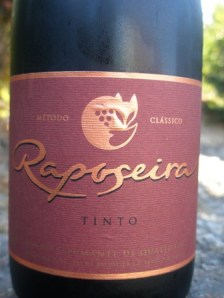One of our day trips from Quinta de Gatao, near Penafiel, was a day trip to see the famous Douro river valley. It was a Sunday morning when we set out, the sky was high and very blue, in short, a terrific day.
We took the rural roads not the highway and descended to the Douro river through a narrow valley on a winding road. It was a wonderful drive. I love driving through almost any rural landscape, then my heart opens up and I feel free. There is so much to see for an agricultural engineer like me: the forests and trees, the fields and the crops, animals, houses, agricultural machinery, irrigation and rivers and of course the peasants.

It was mesmerizing when very of a sudden the river cam into sight for the first time. Majestic it was, large and blue, and of course a cruise ship could be seen slowly making its way down to the city of Porto.

A terrific landscape is the trademark of the region.

Vineyards are all over the place, to be found on narrow terraces, usually just a few rows. Farm houses are also scattered among them. Here and there an olive orchard can be spotted.
Around midday we decided to visit Peso da Régua, a small town and the centre of Port in the upper Douro valley. Our guide book pointed us to Quinta do Castelinho, a winery cum restaurant where we planned to have Sunday lunch.
Since we do not speak Portuguese it was not easy to find the place. Though it was listed in our travel guide, the description how to get there was rather nebulous. After a very friendly man showed us the way, we made a stupid wrong turn and ended up on the freeway into the opposite direction. The rest was easy, we “chucked a u-ie” (no idea what the orthography says about this expression), as we say in Australia, and soon drove right into the yard of the Quinta do Castelinho Winery.

It was a beautiful Sunday lunch; we ordered a kind of continental cuisine. The waiter was very friendly, the service terrific. We had a bottle of their white, still wines which matched the food perfectly. The wine was fresh, clean and crisp, not complicated but a straight forward, excellent table wine.
After lunch we were shown the winery. We watched a introductory film and wandered through the large storage facilities with huge tanks and barrels. The gift shop offered all kinds of local produce and other very attractive items.

With our guide We walked through alleys of huge metal bins.

The wooden storage bins were also enormous.

Some of the items on offer in the gift shop.
Only much later did we learn that Quinta do Castelinho is one of the largest producers of fortified wines in the Douro. The winery is owned by Saraiva family and managed by Manuel António Crúzio Saraiva, the son of the founder who had started the business in the 1960’s. Many of the vineyards are classified as “A”-grade, the best for the production of excellent fruit for fortified wines. This part of the Douro valley is the first ever demarcated wine region in the world. The Marquês de Pombal, prime minister of Portugal, ordered in 1757 that the borders of the valley be marked with solid granite markers. This demarcation coincided with the efforts of navigating the Douro river so that the wines could be shipped down to the port city of Porto.

We tasted also the above two fortified wines.
The Quinta do Castelinho Porto LBV 1997, Castelinho Vinhos (Portugal), left in the picture. The grapes used are: Touriga Nacional, Tinta Roriz, Tinta Barroca, Touriga Francesa
The wine has a dark, ruby red colour. The nose reveals intense and persistent aromas of black cherry, cherry jam, strawberry jam, blueberry and blackberry, some people detect the aroma of violets.
The wine is round in the mouth, well balanced and displays a beautiful finish. We have still one bottle here in Bangkok and treasure it which means that we treat it like medicine until we find a new source of supply.
The wine on the right hand side in the picture above is the Quinta do Castelinho Porto Tawny 10 Years, Castelinho Vinhos (Portugal). The grapes used are the same as the first wine.
The wine shows a deep orangey colour. The nose is rich and intense with aromas of black cherry jam, cherry jam, almond, licorice, cocoa, leather, dried fig and some vanilla. Also this wine is elegant and complex with soft tannins. The finish is also long. It was difficult to decide which one we preferred. Therefore we bought bottles of both of them.

What a beautiful colour
And of course, we tasted some of their famous port wines. We bought a couple of bottle of different port wines as well as some bottles of the white wine we had for lunch which had appealed to us so much.
Because I was the driver, I had to limit my tastings but we left the Quinta do Castelinho wholly satisfied, very cheerful, well fed and with a lot of bottles in our possession.
Address:
Quinta do Castelinho Winery
Castelinho Vinhos S.A.
5054-909 Peso da Regua
Portugal
Tel: +351 254 320 100
FAX:+351 254 320 109
E-mail: castelinho@castelinho-vinhos.pt
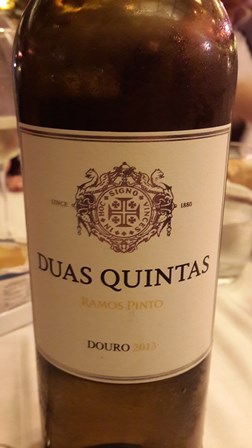
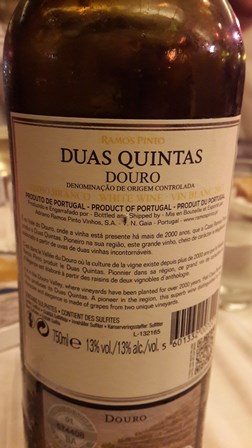
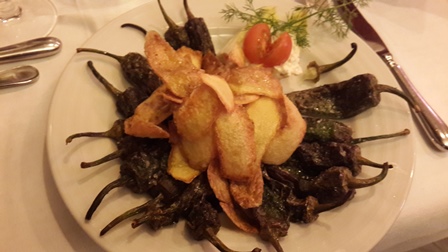
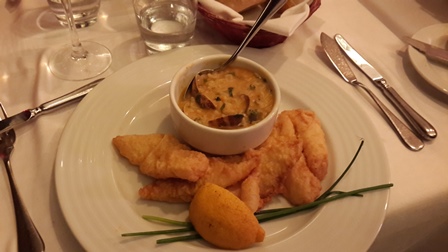



 Posted by themanfrommoselriver
Posted by themanfrommoselriver 























